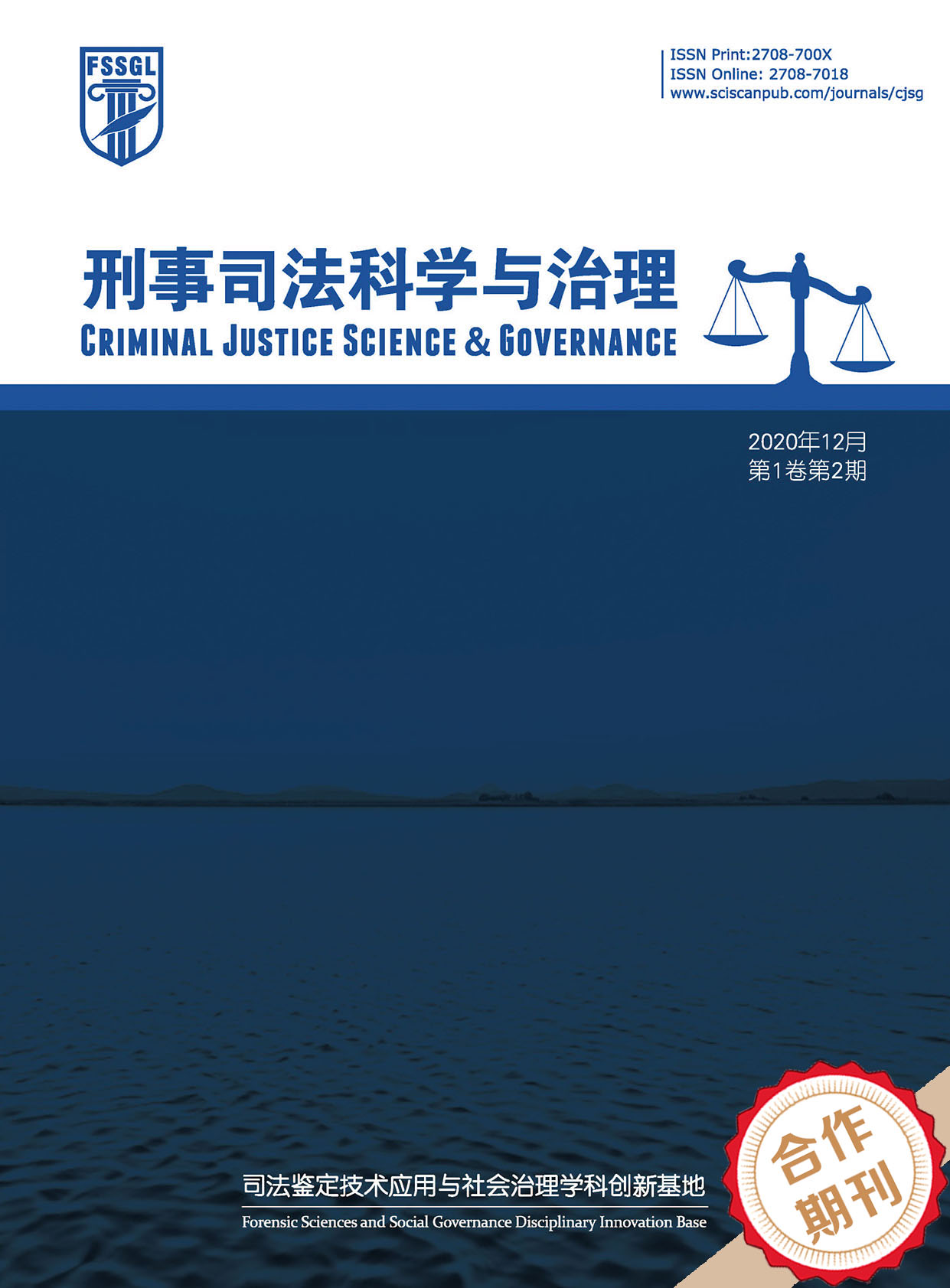Criminal Justice Science & Governance
鉴定意见表述的似然比方法研究
Study of Likelihood Ratio Method for Evaluation of Expert Opinions
- Authors: 王青¹ 杨敏¹'²
-
Information:
1.中南财经政法大学刑事司法学院,武汉; 2.司法鉴定技术应用与社会治理学科创新基地,武汉
-
Keywords:
Expert opinion; Likelihood ratio; Scientificity鉴定意见; 似然比; 科学性
- Abstract: As scientific evidence, expert opinion is an important basis for investigators to solve cases and judges to decide cases. The current binary verdict and the level of probability used in expert opinions have problems such as exaggerated probability and insufficient scientificity, etc. The likelihood ratio method used in the presentation of DNA test expert opinions has attracted the attention of court scientists at home and abroad. The likelihood ratio method is a naturally scientific and legitimate way of expressing the results of identification opinions compared with the traditional mode of expressing opinions. This paper analyzed the problems of the traditional expert opinion model and the advantages and shortcomings of the likelihood ratio expert opinion model systematically, so as to provide reference for the transformation of the scientific evidence evaluation model in the judicial field in China. 鉴定意见作为科学证据,是侦查人员破案、法官判案的重要依据。当前鉴定意见所采用的二元判决以及可能性等级表述方式存在着夸大证明力和科学性不足等问题。DNA 检验鉴定意见表述所采用的似然比方法,引起国内外法庭科学家的关注。鉴定意见结果以似然比方式表述相较传统意见表述模式,具有天然的合理性和科学性。本文较为系统地分析了传统鉴定意见模式存在的问题,以及似然比鉴定意见模式的优势与不足,为我国司法领域中科学证据评价模式转变提供借鉴作用。
- DOI: (DOI application in progress)
-
Cite:
王青,杨敏.鉴定意见表述的似然比方法研究[J].刑事司法科学与治理,2022,3(1):89-95.
一、引言
深入推进以审判为中心的司法体制改革是国家依法治国战略的重要内容,确保侦查、审查、起诉案件的事实证据经得起法律和科学的检验。鉴定意见是证据中的一个重要类型,也是贯彻证据裁判规则的一个重要方面。鉴定意见是具有专门知识的人对需要研判的“专门性问题”进行分析检验并作出的鉴定结果,法官面对蕴含专门知识的鉴定意见难免产生无力感,从而在“不知不觉”中被支配着。鉴定人出庭制度、专家辅助人制度的确立旨在弱化法官与鉴定人之间的支配作用,进而提高法官在涉及非常态知识案件中理性判断的可能。但鉴定人出庭率并没有随着制度的确立而提高,且专家辅助人制度仍将问题解决局限在掌握专业知识的人之间,无法帮助法官跨越法律知识与专业知识间的鸿沟。在这种情况下,国内一些学者将研究目光投向证据评价领域,希望通过便于法官解读的、科学的方式表述鉴定意见,从而推动庭审制度改革,促进司法公正。
詹姆斯·麦克韦斯(James Maxwell)认为“世界的真正逻辑是概率演算”,马克思也曾强调:当一门学问能够成功运用数学时,才算是真正达至完善。随着DNA检验的出现,DNA鉴定结果的似然比表述形式引发了法庭科学领域对于似然比方法的关注。当前,国内外越来越多的学者将研究目光投向似然比在法庭科学中的运用。美国学者萨克斯(Saks)认为似然比将带来司法鉴定科学的范式转移,并指出DNA检验中所采用的似然比评价方式能够为法庭科学的各个领域所借鉴。理查德·伦伯特认为统计学与逻辑心理学将在证据学第三次浪潮中,共同将研究重点从证据规范推向证据过程领域。《欧洲法庭科学评价报告指南》对能够在科学证据中普遍适用的似然率评价方法进行了系统地阐述,并对如何在法庭科学各学科中具体适用进行了说明。澳大利亚学者菲利普·罗斯(Philip Rose)对于似然比在法庭话者鉴别领域的运用进行了深入的研究,通过对元音共振峰等实验测试,认为似然比方法在法庭科学证据评价领域有很大的潜力。越来越多的国内学者也对似然比方法在司法鉴定领域中的运用进行了研究,如张翠玲将似然比方法运用于声纹鉴定领域,董锋等将其运用于枪弹痕迹检验中以及其他学者在赤足足迹、牙印、指纹等鉴定领域中运用似然比进行了研究。以似然比方法进行证据评价能够修正当前二元判决以及可能性等级所造成的鉴定意见过于绝对、分级标准模糊主观等问题。科技在不断发展,证据的评价应当与科技进步同频共振。
鉴定意见的作用在很大程度上是使事实认定科学化,如果法官不能正确全面地解读证据中所蕴含的信息,如何能够发挥证据在科学认定事实方面的作用呢?与传统鉴定意见评价方法相比,似然比方法在评价鉴定意见方面具有其天然的科学性。本文深入分析传统鉴定意见评价方法存在的问题以及似然比方法的运用原理,全面探讨似然比方法在科学证据评价中的可行性和操作性,旨在对科学证据时代下鉴定意见的科学表述方式进行探索。
二、鉴定意见与其表述方法
(一)鉴定意见
鉴定意见是指公安司法机关为了解决案件中某些专门性问题,指派或聘请具有这方面专门知识和技能的人进行鉴定后所作出的书面意见。鉴定意见作为法定证据种类,是鉴定人对专门性问题从科学、技术等角度提出的分析意见,其内容仅限于解决案件所涉及的科学技术问题而不是法律问题。无论何种鉴定意见,均需要具有专门知识的人利用科学的方法、精密的仪器以及先进的技术进行鉴定后出具。司法人员通过知悉这些专业的鉴别和判断,弥补专业知识的局限性,在不同程度上拓展他们对案件事实的认知能力。
(二)传统鉴定意见的表述方式
根据国外学者对于鉴定意见表述方式的调查,现行意见表述方式主要包括:二元判决形式、经典的可能性等级形式、似然比形式。二元判决形式即绝对的肯定与绝对的否定;经典的可能性等级表述形式包括五级分类体系、七级分类体系、九级分类体系。不同国家所划分的等级数量不同,在我国的法庭科学鉴定意见规范中,鉴定意见通常分为“认定、倾向认定、无明确意见(无法判断)、倾向否定、否定等鉴定意见”即五级分类体系。但在实务运用中,倾向性认定往往会被法庭所排除,最终演变成二元判决形式。似然比形式则是对同源与非同源两种可能性从数值上进行表述。
鉴定意见的科学证据外表,导致侦查人员以及检察官、法官对于鉴定意见存在非常严重的盲从现象。何家弘、何然对于刑事错案问题的研究结果表明:20世纪80年代以来我国发生的大约50起刑事错案中有4起存在鉴定结论错误,10起存在鉴定缺陷。由此可以看出鉴定与刑事错案之间有着密切的关系。然而当下侦查人员与检察官、法官却都将鉴定意见奉为真理,尤其是法官对于鉴定意见的绝对信任问题更为严重。一方面是因为审判人员对于专业性问题认知的局限性导致其缺乏对鉴定意见的审查,从而全盘接受鉴定意见;另一方面是鉴定意见具有较高的社会认同度,能够更好地为公众所信服。这导致侦查与审判人员容易忽视与案件有关的其他证据“以鉴代侦/审”,在马德里爆炸案中由于错误的指纹鉴定使得无辜者被误认为作案人,这显然存在着仅关注鉴定意见而忽略其他证据事实的问题。因此正确的采信和使用鉴定意见才能够有效地解决案件中的疑难问题,鉴定意见的表述对于侦查人员以及法官等司法人员正确认识鉴定意见具有至关重要的作用。
三、传统鉴定意见表述存在的问题
(一)过度夸大鉴定意见的价值
二元化的鉴定意见表述,即简单肯定或否定的表述方式,使得该证据的证明力会被不当夸大或者缩小,因此缺乏客观性和科学性。科学证据本身具有不确定性,鉴定意见更是由于鉴定人存在的认知局限性而具有不确定性,鉴定意见的简单表述抹杀了这种不确定性,从而更易使侦查人员、法官被误导。如在指纹鉴定中,同一手指每次形成的指纹都会发生变化,两枚指纹不可能完全相同,鉴定人员只能对特征点进行认定,那么现场遗留的指纹是否具有足够特征信息可供鉴定?在实务中经常会发现在现场上所能提取到的指纹并非是完整清晰的,那么此时局部乳突纹线的符合一定能推导出整体乳突纹线的符合吗?另外,根据刘世权等人对全国司法鉴定机构的指纹鉴定能力测试发现,存在部分鉴定人员对指纹检材与样本存在的差异点没有发现或即使发现也用扭曲和变形对其进行合理化解释的现象。这些都表明如果只追求最终的绝对性结论,在很大程度上会使原本不具有价值的证据进入法庭增加诉累,反之,亦会使具有证明价值的证据被拒之门外。
(二)可能性分级的主观性
无论是五级、七级还是九级模式的鉴定意见都存在一个非常明显的问题,即不同等级之间的划分没有确定的界限,即便有准确的界限也因没有科学依据而备受质疑。以指纹鉴定为例,当两枚指纹符合的特征点达到一定数量即可认定同一,不同国家的标准不同,特征数量的要求基本为8-16个。然而一枚指纹上所存在的特征点可以达到上百个,仅从中找到十几个就可以认定同一,其本身就存在以局部替代整体的问题。在这种情况下,再对等级进行划分即在原有以偏概全的基础上再次进行分化,分级的准确性、科学性难免会受到影响。另外,对不同等级表述的理解也存在主观性。当前,我国的五级鉴定意见表述中使用的是中文修辞,而不同的理解主体对同一词语的理解也存在主观性问题即认知偏差。由于鉴定意见最后的分级表述依赖于鉴定人对于检材样本评估形成的内心确认,因此即使是同一级的鉴定意见内部,不同鉴定人员的内心确信程度也存在着很大的区别。如在倾向认定这一个区间所包含的并非一个确信程度值而是一个区间,区间最小值虽属于“倾向认定”,且同时也非常靠近“无法认定”,区间最大值则更加靠近“认定”,但由于分级表述存在方法上的缺陷,因此最终呈现在侦查人员面前的无论区间最小值还是最大值都是“倾向认定”的表述。这种主观且不够细化的表述容易使得侦查、审判人员的事实认定产生一定偏差,甚至在侦查方向上发生错误从而贻误战机或者造成裁判错误导致冤假错案。
(三)逻辑上缺少对典型性的关注
在逻辑上,当前的鉴定多采用同一认定作为理论基础,即鉴定人员的分析重点在于:检材与样本之间的相似度有多少、存不存在差异以及差异能否得到合理解释从而认定同一。简单来说,鉴定人员的关注点在于特征之间的相似性,对于特征在人群中分布的典型性并没有予以充分的关注。DNA鉴定之所以能够为世界各国所认可,是因为其有足够多的基础数据支撑统计性估量的计算。一些学者主张检材与样本认定同一与所依据的特征在参考背景人群中的分布无关,这显然存在逻辑错误。以纤维为例,鉴定人员发现检材与样本同一,若不考虑该纤维制品在人群中的分布状况则鉴定人员很有可能做出认定意见;然而若在此城市百分之八十的人员都拥有同种纤维制品衣物,那么此时鉴定人员还能做出同一认定意见吗?因此若只单纯考虑相似性必然会导致逻辑上的错误,即如果认定所依据的特征在人群中的分布很罕见,则认定同一的准确性也会非常高,若分布非常的普遍则会使得认定错误的概率大幅上升。
四、似然比方法及其实践
(一)似然比
英国牧师贝叶斯在17世纪提出了一种由果溯因的定理,我们经常碰到的问题是箱子中有已知数量的黑球和白球,随机取出一颗是黑球的概率。而贝叶斯定理针对的是当从箱子中摸出一颗或几颗球时,根据球的颜色来判断箱子内黑球白球的数量比。即当事件B已经发生,求事件B发生的条件下事件A发生的概率。
其基本公式:
P(A|B)=P(A)P(B|A)∕P(B)
可以扩展为:
P(A|B)=
对其进行概率变形则可以得出:
 =
= ×
×
其中等式右边第一项即为似然比,在鉴定领域对似然比的理解为:若检材和样本同源得到此证据的概率与若检材和样本不同源得到此证据的概率之比,即检材与样本的相似性和检材在相关背景人群中的典型性之比。其对于证明力的评价以1为标准:当似然率大于1时,检材与样本同源得到此证据的概率大于检材与样本不同源得到此证据的概率,数字越大对同源假设的支持强度越高;小于1时则相反,越小对非同源假设支持强度越高;等于1时则说明该证据对同源假设和非同源假设支持度相同,此时该证据不具有证明力。
(二)似然比在鉴定意见中的实践运用
概率的诞生最早就是为了服务法庭,在《猜度术》一书中有许多概率问题都与法律有着紧密的联系。概率运用于法庭科学有一定的历史根基,而DNA检验鉴定使似然比进入法庭科学工作者的视野。
DNA检验鉴定建立在遗传学和统计学的基础之上,以似然率的形式对鉴定结果做出表述。DNA对遗传信息进行复制,从而使不同细胞世代之间的遗传信息得以延续。DNA存在于染色体结构之中,具有遗传效应的DNA片段为基因。基因在染色体上的位置为基因座,一对染色体的同一基因座上的一对基因为等位基因。根据孟德尔生物遗传定律,个人的等位基因一半源自父亲一半源自母亲(基因突变除外),这就给人身认定提供了遗传学基础。DNA检验鉴定的统计学基础在于似然比方法的运用。人类DNA基因座有数十万之多,研究人员从中对比选择出了数十个具有遗传多态性的基因座进行分型,运用似然比或者偶合概率来进行评判。以刑事案件中现场遗留的血液检材为例:现场遗留血液的DNA与犯罪嫌疑人DNA吻合支持同源认定的概率与现场遗留血液DNA与犯罪嫌疑人之外的其他人DNA吻合支持同源认定的概率之比,即为DNA鉴定的结果。其似然比形式经常表述为:LR=m×10-n(m,n>1)。四川省绵阳市中级人民法院(2019)川07刑初12号刑事判决书中的DNA鉴定即表述为“董某1右大腿外裤部疑似血迹拭子(编号1-6)、送检的血迹拭子(现场自编号10、11、13、35-37)检验出的人血及STR分析,与秦启鑫的血样在D8S1179等20个基因座基因型相同,似然比3.66×1027”,显而易见结果能够证实个体唯一,因此可以认定同一。这种利用似然比进行认定的方法提高了结果准确性,使用更为科学的方法得到鉴定结果,增强了鉴定的科学性。此外DNA的个体特异性能够迅速锁定嫌疑人,减少冤假错案,如美国的“无辜者计划”通过利用DNA证据纠正了数百起刑事冤案。虽然DNA检验鉴定的科学性已经得到了世界各个国家的认可,在法庭科学领域DNA鉴定意见可以称得上是“证据之王”,但也并非完美无缺,首先运用DNA进行同一认定的基础在于每个人的DNA是独一无二的,但随着实践与科研探索表明其个体特异性存在例外。同卵双胞胎或多胞胎其DNA序列相同,以及一个人体内同时存在多套DNA序列的“奇美拉”现象。当个体特异性不存在后,也就失去了进行同一认定的基础。其次,DNA作为生物检材,其本身就存在易受污染和容易灭失等问题。DNA样本和检材在进行鉴定之前要经过提取、保存、运输等诸多环节,每一环节都需要人的参与,这使得鉴定结果难免会存在误差。最后,一个潜在却危害严重的问题是,法庭对DNA鉴定意见的盲目采纳,有学者对此进行调查发现:作为应对证据真实性把关的法院,对控方提交的DNA证据的相信率高达99.65%。因此,即便是得到世界公认、准确率极高的DNA也存在着因污染或人为操作等问题带来的误差,利用似然比进行表述在很大程度上也是在提示法官要注意那微乎其微的百分之零点几。
五、似然比方法鉴定意见评价
(一)似然比评价鉴定意见的合理性
1.避免绝对化表述,全面把握鉴定意见
我国鉴定意见报告书通常对结论进行简单绝对的肯定/否定表述。简单地肯定或否定将结果的确定性程度提高到了百分之百,但由于认知偏差或技术误差等原因造成任何鉴定都不可能达到完全确定,鉴定人员简单地使用鉴定意见的绝对性表述其实是在变相掩盖这种不确定性。部分领域的鉴定意见虽是依据成熟且经过反复检验的科学理论得出的,但需要注意的是:科学是动态的,永不停歇一直发展的。科学只是在现有社会物质条件下成立的有局限性的理论,科学不等于绝对真理。正如相对论的提出打破了绝对时空观,鉴定所依据的科学理论现在看来是正确的,经过不断地发展后却很有可能被推翻。事实证明,人们长期以来一致认为的DNA证据具有绝对准确度也存在一定的概率性。另外,科学技术并非绝对精准,而是存在误差。无论是当前人类所能制造出的设备精确程度有限,还是制定的实验方法受认知局限制约,科学技术总会存在一定的误差。依靠科学技术进行实践的鉴定,必然包含着不确定性,这种不确定性来源于科学本身。没有哪个鉴定人员可以对鉴定结果达到百分百确信。
通过似然比量化表述,能够更加清楚客观地将检材和样本对于同源/非同源假设支持的比率展现在侦查、审判人员面前,使他们能够更加客观、全面地看待该证据的证明力,避免一概而论忽略潜在的不确定性,能够以更加准确的数值界定分级鉴定意见确信度区间。以似然率对鉴定意见进行评价,并不会大幅度增加侦查人员对鉴定意见的理解难度。似然比不仅具有数字的表述形式,为了方便侦查人员、法官等不具有相关统计学知识的人员更好地理解似然比所代表的含义,似然比还包括文字类型的表述。美国学者认为专家证人以似然比评价证据的正确表述为“无论其他证据支持假设的优势比有多大,我所提供的证据都将使其翻R倍”,在一定程度上可以避免使用其他概率评价方法所产生的难以理解的问题。
2.规避结合悖论,加强证据结合
除了似然比的方法还有诸多学者提出了以其他概率方法进行证据评价,如培根式概率、模糊概率、概率树等,但在这些概率方法使用过程中不可避免的是:在证据结合时极易产生结合悖论问题。结合悖论产生的根本原因在于乘积原则在多要素事实认定活动中的机械运用。在一个案件中通常不止一项证据,以民事诉讼中的高度盖然性标准为例,在一个案件中存在三项证据且均超过证明标准下限,如60%,三者同时发生的概率为0.216。若在此时增加一项依据经验常识不对最终事实认定产生影响的证据,即其发生概率为50%。根据乘积原则四者同时发生的概率为0.216×0.5=0.108。通过对比可以发现,新增证据虽为无关证据,却对证据结合后的概率产生了影响,乘积原则无法规避无关证据的影响。与此相较,似然比的一个显著优势是:各种证据的似然比可以合并,合并过程中能够有效规避无关证据的影响。运用似然比表述鉴定意见,当新的证据加入时同样采用相乘的方式来更新侦查、审判人员信念,但由于似然比的范围为(0,+∞),因此其乘积结果与证据对于假设的支持程度相关,当支持程度越大似然比值越接近正无穷,越小越接近0。因无关证据对控辩双方假设的支持程度相同,所以其似然比值为1。当运用乘法对多个证据的似然比进行合并时,无关证据不会对比值产生影响,能够有效规避结合悖论中无关证据的影响。
3.提高诉讼效能,减少错案发生
在鉴定人员分析判断结果与规定的肯定或否定标准存在一定差距但又要求必须做出绝对性的结论的情况下,其做出的鉴定意见在一定程度上对证据价值进行了夸大。在侦查阶段该证据的证明力极有可能会被侦查人员与犯罪嫌疑人质疑,从而导致重新鉴定。重新鉴定有利于保障犯罪嫌疑人的异议权,但有时犯罪嫌疑人为了得到有利于自身的鉴定意见而不断要求重新鉴定,从而对司法资源造成浪费。若前后两次鉴定意见不同如何采信,是否会对司法鉴定公信力产生影响?即使得到了侦查人员和犯罪嫌疑人的认可,进入庭审阶段也极易受到法官的质疑,从而影响庭审效能。使用似然率进行鉴定意见评价更加客观,鉴定人员只需要提供似然比,即只表述对主张的支持程度,不必独立证明案件事实,能够避免审判人员根据绝对的肯定/否定“以鉴代审”的现象。绝对化的表述,如“该鞋印是某人留下的”,易使审判人员产生该人即为作案人的判断,从而导致鉴定人员越俎代庖侵占审判人员的决定权,变相地将风险转嫁给鉴定人员,更加容易导致错案发生、影响司法公正。以似然比的方法进行鉴定意见评价不仅考虑了检材和样本的相似性,也考虑了样本在相关背景人群中的典型性,避免了简单的二元化和分级表述在逻辑上的缺陷。相似性与典型性概率值明示化,有利于侦查人员客观地看待怀疑对象的嫌疑程度,促使严格侦查,防止刑讯逼供,保障无罪的人免受刑事追究,有利于审判人员从全案证据出发,一定程度上避免错案的发生。
(二)似然比评价鉴定意见的局限性
1.似然比并未突破鉴定方法的主观性
对于鉴定意见进行似然比的方式评价,其分母其实就是对某特征在人群中的典型性进行考察。当前对于似然比的质疑很大一部分来自对背景人群分布数据来源可靠性的质疑。在一些鉴定领域存在着可靠且被检验过的数据库,如DNA分析在医学领域经过了长期的实践检验,从医学领域进入到司法鉴定领域是建立在有大量基础数据库、文献分析的基础之上。对于其他鉴定领域尤其是形象特征鉴定,却缺乏相应的数据基础。有学者提出在形象特征鉴定中可以根据鉴定人员研究学习的成果和实践经验来给出似然比。但这一做法受到了很多学者的质疑,认为其是无效的。虽然我国当前除DNA鉴定外尚不允许使用似然比进行鉴定意见表述,但在欧洲的很多国家,根据专家判断给出似然比的做法非常普遍。似然比表述鉴定意见,尤其是无基础数据支撑的似然比是否有效,在不久的将来也会是我国学界需要考虑的问题。依据专家经验得出的似然比表述的主观性很大程度上来自于鉴定方法本身具有的主观性,在这种情况下是否应当对由此得出的似然比表述是主观的进行质疑值得思考。在这种情况下得出的似然比表述是否应被质疑是主观的值得思考。
2.数据库建立的困难性
上文提及,似然比的得出与数据库息息相关。对于有关物理、化学成分的鉴定其数据库的建立是相对容易的,但其他大部分领域其数据库的建立却存在较大的困难。以笔迹鉴定的特征选取为例,在建立笔迹数据库时对于特征的选取自然是优先选取普遍性、稳定性较高的特征,否则数据库的代表性就会大打折扣。在实务工作中,检材和样本经常出现不常见但能够很好地反应书写人书写习惯的特征,这些特征通常是鉴定人员的重要参考。这些个性化强、价值高的特征却很难进入数据库中,容易导致似然比鉴定意见评价方法的非全面性。数据库还存在时效性问题,如指纹可以利用弓、箕、斗纹等作为特征点,然而指纹不仅存在先天形成的,还包括后天形成的特征如疤痕,数据库建立后很难对后天形成的疤痕进行及时更新,以致于在很大程度上会使在非充分的数据库基础上得出的似然比的准确性大打折扣。总之,无论是对于指纹抑或是笔迹、声纹等数据,收集仍然是一项非常困难的任务,且不说数据库如何制定标准的问题,仅就我国人口、汉字、方言众多想要收集齐全无疑是一项非常困难的任务,再加上后天因素以及声纹中信道不同等影响因素,全面高质量的收集很难实现。只有解决这些问题才能创建相对充分的基础特征数据库。
六、结语
当前,我国以似然比方法进行鉴定意见表述尚处于探索阶段。无论是在基于科学技术、先进仪器进行的鉴定中,还是在根据长期实践总结的经验性知识进行的鉴定中,与优化选取特征、提高鉴定方法相比较科学化鉴定意见表述尚处于下位,但应当看到的是在短时间内诸多鉴定领域难以在特征、方法上有科学性、准确性的提升,提高鉴定意见质量,加快推进统一司法鉴定管理体制迫在眉睫。不可否认,以似然比方法评价科学证据并没有从方法上增强鉴定意见的客观性,并且建立判断典型性所依赖的数据库存在诸多困难。通过加强司法鉴定与包括统计学在内的多学科融通,进一步完善似然比在鉴定领域的运用。似然比在我国法庭科学证据评价领域的运用尚有很长的探索之路要走,越来越多的学者认识到采用似然比方法对鉴定意见进行表述更加具有科学性与客观性,国际上也有越来越多的国家允许采用似然比方法进行证据评价。使用似然比方法对鉴定意见进行表述有其科学和实践价值。
















